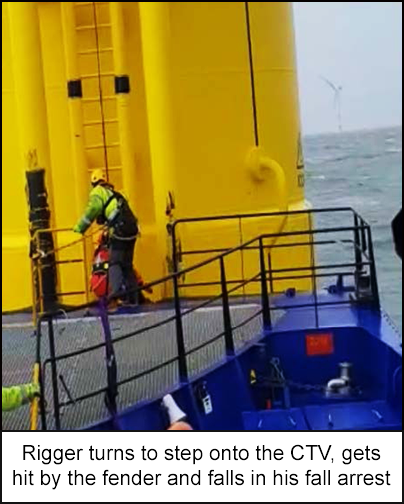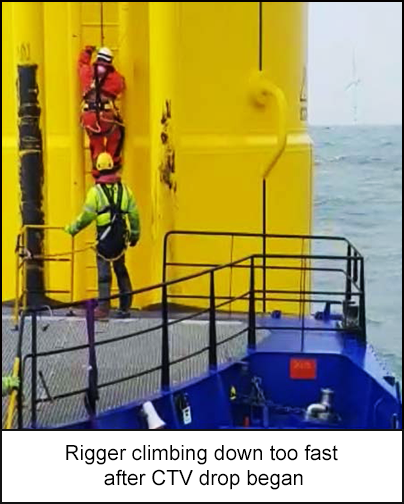-
What happened?
A crew was transferring from a transition piece (TP) onto a crew transfer vessel (CTV).
The weather forecast was good and within operational limits, but rapidly deteriorated during transfer.
Five riggers transferred successfully.
When turning to step over from the TP and onto the CTV, the sixth rigger was hit by the CTV fender.
He fell into his fall arrest, becoming positioned in the gap between ladder and fender for a short period of time.

-
Why did it happen?
Procedure was not strictly followed:
- Injured person climbed down too fast, not synchronising with the deckhand’s countdown.
- His fast descend left him no time to monitor and react when the CTV started to move.
Deteriorating weather, which caused the CTV to move:
- Forecast was good and within CTV operational limits when the transfer started.
- During operations, all vessels were informed by the Marine Coastguard that the weather was deteriorating fast.
Unclear procedure for aborting operation:
- Push-on tests were carried out at regular intervals. Results were good, although marginal until the time of the incident.
- Decision to abandon the location was made whilst 100% push-on power was required.

-
What did they learn?
Continuously monitor weather forecasts and observe weather on site. This is essential for adjusting planning during operations.
Master and superintendent should initiate a re-assessment of the job when weather is deteriorating.
Ensure all crew are aware that climbing and descending TP ladders should take place at a controlled pace and in line with the deckhand’s countdown.

-
Ask yourself or your crew
How can something like this happen here?
How do you know when it is safe to descend from the TP ladder and step onto the CTV?
Why are push-on power tests important? How do the results influence operations?
What more can we do to prevent incidents during vessel transfers?

Add to homescreen
Content name
Select existing category:
Content name
New collection
Edit collection
What happened?
A crew was transferring from a transition piece (TP) onto a crew transfer vessel (CTV).
The weather forecast was good and within operational limits, but rapidly deteriorated during transfer.
Five riggers transferred successfully.
When turning to step over from the TP and onto the CTV, the sixth rigger was hit by the CTV fender.
He fell into his fall arrest, becoming positioned in the gap between ladder and fender for a short period of time.

Why did it happen?
Procedure was not strictly followed:
- Injured person climbed down too fast, not synchronising with the deckhand’s countdown.
- His fast descend left him no time to monitor and react when the CTV started to move.
Deteriorating weather, which caused the CTV to move:
- Forecast was good and within CTV operational limits when the transfer started.
- During operations, all vessels were informed by the Marine Coastguard that the weather was deteriorating fast.
Unclear procedure for aborting operation:
- Push-on tests were carried out at regular intervals. Results were good, although marginal until the time of the incident.
- Decision to abandon the location was made whilst 100% push-on power was required.

What did they learn?
Continuously monitor weather forecasts and observe weather on site. This is essential for adjusting planning during operations.
Master and superintendent should initiate a re-assessment of the job when weather is deteriorating.
Ensure all crew are aware that climbing and descending TP ladders should take place at a controlled pace and in line with the deckhand’s countdown.
Ask yourself or your crew
How can something like this happen here?
How do you know when it is safe to descend from the TP ladder and step onto the CTV?
Why are push-on power tests important? How do the results influence operations?
What more can we do to prevent incidents during vessel transfers?
A crew was transferring from a transition piece (TP) onto a crew transfer vessel (CTV). When turning to step over from the TP and onto the CTV, a rigger was hit by the CTV fender. He fell into his fall arrest, becoming positioned in the gap between ladder and fender for a short period of time.











